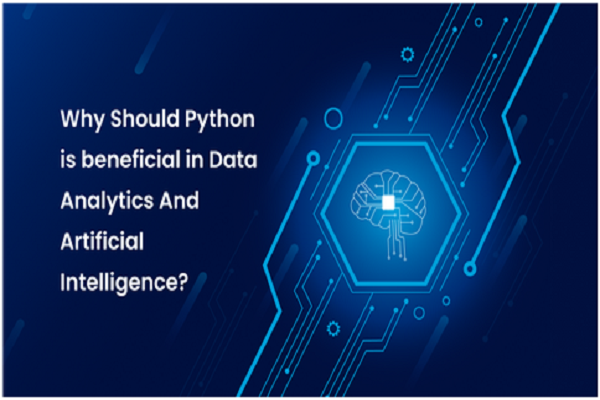Applications for artificial intelligence (AI), machine learning (ML), and data analytics use a range of technological stacks. However, the best programming language for AI must be robust, scalable, and readable. And the Python programming language satisfies each of these three aspects; the general reason is why businesses hire Python programmers for such application development.
Python has a successful track record of harnessing AI, ML, and data analytics with top-notch libraries, tools, and frameworks. Python is perfect for ML and AI-driven applications since it supports sophisticated AI and ML modules. Python also enables programmers to boost their confidence and productivity when utilizing these technologies due to its simplicity and versatility.
The combination of these factors makes Python the most successful AI programming language, which boosts its popularity.
Python is good for Data Analytics and AI - Why?
Python was released in 1990, but it wasn't until recently that it started to garner popularity. With 44.1% of developers using it in 2020, Python surpassed JavaScript, HTML/CSS, and SQL as the fourth most popular language.
Python is an object-oriented, general-purpose, interpreted high-level language. The language is used to create APIs, AI, websites, and the Internet of Things, among other things. Python's popularity is partly because data scientists use it a lot. It features one of the most outstanding libraries of any language, is simple to learn, and is ideal for all phases of data analysis.
Another name for Python is "general-purpose programming language," even though it stresses readability. Engineers can perform tasks with fewer lines of code, thanks to Python. Python is rather fast, and several packages, such as Matplotlib, make it more attractive.
Thus, apart from the key factors that make Python the ideal programming language for data analytics and AI, businesses because it is open source. Apart from this, they got some additional aspects, such as Python's high speed & seamless assistance have made it a most sought-after among many.
Why is Python so popular in AI and Data Analytics?
Let's look closely at the factors contributing to Python's popularity in AI and Data Analytics.
1. Rapid development and readability
Python promotes quick development since programmers, even those who join projects in the middle can easily comprehend what is taking place in the application. No ambiguities, errors, or paradigm conflicts exist while using Python.
It facilitates sharing of algorithms, resources, and concepts among AI, ML, and data analysis experts. The optimization of Python code is also a simple process. Tools like IPython include additional features that might help businesses streamline their procedure, such as testing, debugging, and tab completion, giving them more reasons to python web development company.
2. AI, ML, and Data Analytics Libraries
A substantial collection of AI, ML, and data analytics libraries are available in Python. The most well-known Python libraries for AI/ML & data analytics include:
●Scikit-learn: Basic ML methods like clustering, regression, and classification are handled by Scikit-learn.
●Pandas: Pandas is a computer language that may be used to organize and perform complicated data analysis. You can combine and filter data with it & get information from other sources.
●NumPy: NumPy was created expressly for data science calculations. It's a superb Python multi-dimensional array object package that enables you to carry out mathematical operations. Python and NumPy collaborate to make the software's computations less difficult.
●Matplotlib: Python's Matplotlib library is for plotting the data. It includes data exploration and visualization features that make it simple to create different scatter plots, diagrams, histograms & other visual representations of data. With visual representations, Matplotlib makes it easier to manipulate data to personalize Python AI apps.
●TensorFlow: With large amounts of data, artificial neural networks can be built, trained, and employed with TensorFlow.
3. Visualization Capabilities
As mentioned earlier, Python offers huge libraries, many of which provide excellent visualization features. Programmers can use resources like Matplotlib while creating applications for data science, for instance, to better understand, present, and visualize data.
The most crucial component of ML, AI, and deep learning algorithms is data, and visualizing data makes it easier to spot patterns and monitor data across the web and on social media platforms.
4. Flexibility
Python is a versatile programming language that lets programmers use scripting or object-oriented programming (OOP). Python can be used in conjunction with other languages by developers to get the desired results, which lowers the likelihood of errors.
Businesses hire Python programmers because Python further reduces the requirement for source code recompilation, allowing easy viewing of results. Python offers programmers the most creative freedom when developing related apps because of its adaptability.
For instance, Python offers uncomplicated frameworks like Keras to train ML models when building them. Then, ML models can be installed and managed continuously via MLOps systems, ensuring model monitoring and management.
The Bottom Line
Any firm that requires a competitive edge on the market and makes reliable choices now relies heavily on data. Several languages are used for data analytics and AI; the most popular ones are R, SQL, Julia, and Scala. Every language excels at specific data development tasks over others. There is no ideal language; only one is better suited to your project.
Nevertheless, Python is still the most widely used language, and most businesses hire Python programmers for AI and data analytics. It is among the simplest languages to learn, has a large community that can offer assistance if something goes wrong, and has several libraries that assist data analysts at every stage of their work.
Python is a highly effective language for AI/ML & data analytics applications because it has the processing capacity and scalability to handle enormous data demands while being highly flexible and simple to learn. So, if your business needs to build such applications, ensure to hire the best Python programmers!
